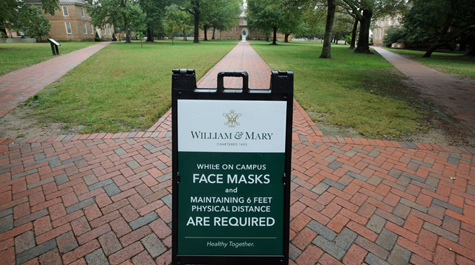Contact tracing arrangement with VDH helps W&M contain COVID-19 cases
As medical director of William & Mary’s Student Health Center, Dr. David Dafashy helps coordinate the university’s part in contact tracing. Seven months ago, just as COVID-19 began changing our way of life, he was one of the first to be traced.
It was March 11, the same day W&M canceled in-person classes for the remainder of the semester. Dafashy was in his car when he got a call from Cynthia Rieken, an epidemiologist with the Virginia Department of Health.
Dafashy was told he had been in close contact with someone who had tested positive for the novel coronavirus. Rieken could not identify the person but was able to say the exposure had taken place March 1, when he was one of nearly a dozen people at a dinner party.
Dafashy ended up contracting the virus, one of the early cases in Williamsburg, but has since recovered. Now, he’s fighting it from the medical side, and part of that is contact tracing — tracking down those who have been in contact with a known case and advising them what to do next.
Dafashy helps coordinate W&M’s contact system with the Virginia Department of Health, which has five tracers working out of an office just off campus.
“We will identify immediate contacts — partners, roommates — but we don’t do exhaustive contact tracing,” Dafashy said. “That’s what the VDH’s responsibility is. What we try to do at the student health center is identify cases and have them removed from the general population.
“While we’re not contact tracers, I think the VDH values our ability to identify these people, isolate them promptly and quarantine the obvious close contacts so that by the time they reach out, they’re doing more extensive contact tracing. It’s a two-step process. We do that, and they expand it.”
The concept of contact tracing is not new. Amid a cholera outbreak in 1854, a London doctor named John Snow traced the source to contaminated water by talking with local residents. More recently, in 2016, it helped stop the spread of Ebola in West Africa.
However, until COVID-19, it had been rarely used in the United States.
“Contact tracing has been around since humans realized that if you have a disease, people around you get it,” said W&M Assistant Professor Iyabo Obasanjo, a member of the university’s Public Health Advisory Team who specializes in global health and teaches classes in contact tracing. “If you had symptoms, you stayed somewhere away from others and everybody who had contacted you stayed away too. Every culture worldwide had it.”
“In the U.S., it hasn’t been used as much mostly because none of the top 5 causes of death were infectious (diseases). Before COVID, it was mostly used with sexually transmitted diseases. I think part of the slow response for U.S. public health system is that it had not been using contact tracing for these kind of diseases for a long time.”
After receiving word of a positive test for COVID-19, a contact tracer will reach out to the individual and get names of those with whom he or she had been in close contact — now defined as within six feet for more than 15 cumulative minutes over a 24-hour period. Those who live in the same household are automatically notified.
Once reaching out to those on the contact list, the tracer will provide information on symptoms, testing, and quarantine periods. The positive test case’s identity will not be revealed unless he or she gives permission.
“Contact tracing is important for any community to keep the spread to a minimum but particularly for the student population, which is often asymptomatic or mildly symptomatic,” said W&M Chief Operating Officer Amy Sebring, who chairs President Rowe’s Public Health Advisory Team. “They are not likely to be aware they’ve been around someone who has the virus.
“I appreciate VDH’s willingness to partner with us. Obviously, their scope is state wide, but college campuses are unique communities with high levels of interaction. Having them on campus with us and with the ability to respond quickly has really been important.”
Sebring believes having five contact tracers from the VDH dedicated to William & Mary has helped keep the numbers low. Only about 0.5 percent of the student population has tested positive.
“Huge kudos to our students for taking it seriously and doing their part to minimize spread,” Sebring said. “But it’s inevitable: People are going to get the disease and when they do, having contact tracing immediately available to track down others who might unknowingly have had contact is really important.”
Though contact tracing faces obvious challenges in a large setting, such as the continental United States, it has proven to be an effective strategy in containing the spread of infectious diseases in more confined areas.
“The number one part of the strategy was to make sure that everybody who came in was negative,” Obasanjo said. “So you start with a clean slate and then you start to test, which is what William & Mary’s campus has done.
“Then you contact trace all of your positive cases and quarantine their contacts ahead of them spreading it to others. That’s what we’re doing now.”
















